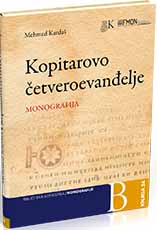Kopitarovo četveroevanđelje : monografija
Kopitar's Gospel: Monograph
Author(s): Mehmed Kardaš
Subject(s): Cultural history, Morphology, Historical Linguistics, South Slavic Languages, 13th to 14th Centuries
Published by: Slavistički komitet BiH
Keywords: Jerinej Kopitar; Gospel; Bosnian Church Slavonic; Glagolitic script; Cyrillic alphabet;
Summary/Abstract: Stored in the National and University Library in Ljubljana under the signature mark Cod. 24, Kopitar’s gospel is one of about thirty preserved texts of the Bosnian Church Slavonic literacy. The codex was written in the second half of the 14th century under the auspices of members of the Bosnian Church, but soon after the fall of the Bosnian Kingdom it was preserved in an Orthodox monastery, where its original appearance was changed by reparations and adjustments to suit the Serbian Orthodox Church liturgy.The philological analysis of this relatively well-preserved codex imposed itself as a research task whose results should provide the most important knowledge about the codex itself and the process of editing its text at all levels of realization, as well as the position of the manuscript in relation to the Church Slavic canonical and the Bosnian group of codices.The entire codex, which is by all features – codicological, graphetic and linguistic – a typical representative of the Bosnian tradition, was more or less carefully written in the Bosnian Cyrillic by one scribe. The majority of medieval Bosnian religious texts were written in the same type of this version of the Cyrillic alphabet, which, along with lapidary and office script,represents a version of the Western Cyrillic script.Orthographic features of Kopitar’s gospel are shown in adhering to the Bosnian spelling tradition, which follows the oldest Old Church Slavic matrix, primarily the Glagolitic script, which is confirmed in the solutions of ambivalent values of individual letters. In addition to their true values, the letter ѣ has the value /ja/; the letter е serves as the value /je/ in the initial and post-vowel position; letters л and н entail the values /ĺ/ and /ń/; whilethe letter jerv only had the value /đ/ for the scribe of Kopitar’s gospel. Aslight distance from the Bosnian spelling tradition can be assumed in amore frequent use of ligature ѥ.The language of Kopitar’s gospel marks the breakthrough of dialectal innovations from the Western Shtokavian base. Besides Ikavian as a distinguishable feature of this literacy which is in Kopitar’s manuscript massively present and most likely indicates the Ikavian organic idiom of the scribe, other western features are also registered in the codex: the reflex/j/ < *dj, and, rarely, the reflection of the group va < vь. Furthermore, in the entire codex, other linguistic features are recorded, which testify about the condition of the Shtokavian speech during the second half of the 14thcentury, such as the vocalization of the semivowel u /a/, the reflex /u/ < vь,etc. Since there are no examples in the codex of changing the final l > /o/which is found in other Bosnian gospels written at the end of the 14th and the beginning of the 15th century, this leads to the conclusion that the time of writing of Kopitar’s manuscript could be moved towards the middle of the 14th century.
- Print-ISBN-13: 978-9958-648-27-4
- Page Count: 260
- Publication Year: 2020
- Language: Bosnian
- eBook-PDF
- Sample-PDF
- Table of Content

